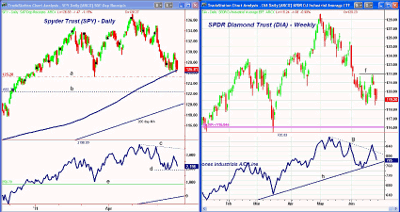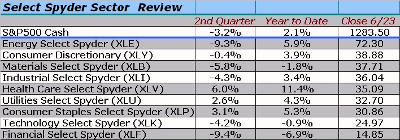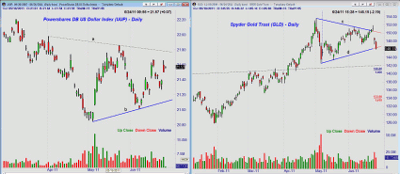Something's got to give as we approach Independence Day, as the quixotic action last week hurt both quick-hit traders and longer-term investors. But an early rally next week would improve the outlook greatly, writes MoneyShow.com senior editor Tom Aspray.
As someone keeps a close eye on not only the US, but also overseas markets, last week was tough. There were violent swings in many key markets
Last week’s trading had something for everyone. As the rally in the stock market fizzled last Wednesday, it was taken calmly by most. Then the IEA’s action on oil reserves Thursday gave all the markets—but especially traders in the oil pits—a full-body slam.
Those who were buying puts and shorting stock-index futures early in the week were very happy, but the last hour rally Thursday took away many smiles. The 30-minute, 13-point upside reversal in the S&P 500 was one of the more dramatic moves I have ever seen.
The heavy volume suggested a potential selling climax, but the market’s failure to close above the prior week’s highs on Friday means the jury is still out. If nothing else, Thursday’s action likely shook the confidence of those who are betting on a much stronger market decline.
Though both long term and short term technical evidence suggests that we are in the process of forming a bottom, there are several storm clouds on the horizon that can’t be ignored.
The weakness in stocks on Friday was spurred by the sharp declines in many of the European banks. The markets are not only concerned about how much exposure they may have in other weak Euro countries besides Greece, but also how much exposure US money-market funds have to the banks' debt.
The top-left chart above shows the sharp slide in Barclays PLC (BCS) as it gapped lower Friday on heavy volume. It is down 28% from early March, and has broken below major support (line a). The on-balance volume (OBV) is in a solid downtrend (line b), indicating that money is flowing out of this stock.
Even though Switzerland is not a Euro country, and has the strongest currency in the world, the Swiss bank UBS AG (UBS) has also been hit. It is down 15% since the start of May. It has also broken short-term support (line c), and its OBV looks weak.
The sentiment in the junk-bond market also saw a dramatic change recently, as $5 billion has come out of junk-bond funds in the past two weeks.
The chart of the SPDR Barclays Capital High Yield Bond ETF (JNK) shows the drop through weekly support from the fall of 2010 (line e). Volume was very heavy on the break, but the OBV gave a good warning as its uptrend (line f) was broken in March.
This may be a further warning for equities, as these bondholders are worried about another recession and a pick-up in defaults by bond issuers. If you are in some of the other junk-bond ETFs, like iShares iBoxx $ High Yield Corporate Bond ETF (HYG) and PowerShares Fundamental High Yield Corporate Bond Portfolio ETF (PHB), I would watch the action closely.
Commodity investors were also not immune, as precious metals reversed course, and many of the commodity indices also took a beating last week. My long-term outlook for the commodity markets still suggests that this correction will be a buying opportunity, but not until we see prices bottom out.
No real surprises last week from the economic reports, and there is a fairly full calendar this week. Personal income is reported Monday, followed by consumer confidence on Tuesday.
We also get more information on the housing market, with the Case-Shiller Home Price Index report Tuesday, followed by pending home sales on Wednesday.
Jobless claims numbers come on Thursday. Finally, just before the long weekend, we get consumer sentiment, the ISM Manufacturing Index and the monthly reading on construction spending.
NEXT: WHAT TO WATCH
|pagebreak|WHAT TO WATCH
S&P 500
The Spyder Trust (SPY), after rallying to a high last week of $129.81, closed not far above the widely watched 200-day MA of $126.52. Friday’s weak close suggests this level may be broken. This makes the March lows at $125.28 (line a) even more important.
A close under this level could cause a quick downdraft to the $123.40 to $122.30 area (line b), which corresponds to the 38.2% support and the October 2010 highs.
Such a decline may be signaled in advance by a drop in the S&P 500 A/D line below the recent lows (line d). If last week’s lows in the SPY are broken, but the A/D line holds its lows, it would be a short-term positive.
The S&P 500 A/D line has much more important support (line e), and needs to move back above resistance (line c) to turn positive. Key resistance now stands at $129.81, and a close above it should signal that the decline is over.
Dow Industrials
The rally in the Diamonds Trust (DIA) appears to have stalled at $121.91, not far below 38.2% resistance at $122.36. The daily downtrend and the 50% resistance are at $123.57.
The daily A/D line on the Dow Industrials broke its short-term downtrend (line g) last week, which was an encouraging sign. It needs to now move above last week’s high to complete the bottom formation.
The key support level to watch is last Thursday’s low at $118.41, followed by 38.2% support at $116. The March lows sit at $115.51.
Nasdaq-100
The PowerShares QQQ Trust (QQQ) rebounded most impressively from last Thursday’s lows, as it closed higher for the day. Still, the resistance at $55.37 to $55.47 needs to be overcome to turn the focus on the upside.
Last week’s lows of $53.62 held above the 38.2% support level at $52.83. Volume was lower on Friday’s decline.
Russell 2000
The iShares Russell 2000 Trust (IWM) held well above the recent lows at $77.23, and closed Friday above the prior week’s highs at $79.68. Next resistance stands in the $82 area.
This is a positive sign...but there may be some distortion, as the yearly rebalancing of the Russell Averages occurs after the close.
The 38.2% support from the 2010 lows sits at $76.11.
First daily resistance stands at $79.68, and a close above this level should signal a rally to the resistance at $80.50.
NEXT: Sector Focus
|pagebreak|Sector Focus
All of the Select Sector SPDR ETFs were lower Friday except for the utilities. As the table above indicates, it has been a rough quarter for most of the sectors. To read a full analysis of the Sector ETFs, click here.
- My favorites remain the Select Sector SPDR Health Care (XLV), Select Sector SPDR Consumer Staples (XLP) and the Select Sector SPDR Utilities (XLU).
- The Select Sector SPDR—Consumer Discretionary (XLY) was just added, as its RS analysis has turned positive.
Oil
The panic plunge in crude oil spread to all of the markets on Thursday. The August crude oil contract is now trying to hold the support in the $91.60 to $92 area. A break of this level would indicate a drop to the $88 area.
Some are now looking for even lower prices, but I am not yet convinced. If nothing else happens to dramatically influence crude-oil supplies, I would expect another broad trading range to develop.
US Dollar
The PowerShares DB US Dollar Index Bullish Fund (UUP) gapped higher Thursday, but is still below the resistance at $21.80 to $21.90 (line a). If it is overcome, there is additional resistance at $22 to $22.20.
The chart formation (lines a and b) looks like a continuation pattern. This suggests that an important low is not yet in place, and we could see a further dollar decline.
Gold
The SPDR Gold Trust (GLD) spiked through the upper boundary of its triangle formation (line c) on Wednesday, stopping out anyone on the short side. However, the drop last Thursday confirmed the bearish outlook.
The support (line d) was broken last Friday, with next targets at the support in the $144 to $143 area. I would not be surprised to see the May lows at $142.55 broken with converging Fibonacci targets (see chart) in the $140.70 to $140.80 area
Resistance is now strong in the $149 to $150 area.
Silver
The iShares Silver Trust (SLV) is holding above the support at $33.60, but I would expect it to be broken early in the week.
This suggests a drop at least to the $32 level, if not $30.
Interest Rates: The yield on the ten-year Treasury closed at a year-to-date low Friday at 2.87%, after dropping from a high of 3.61% on April 8. The key support lies at 2.40%.
The 50-day moving average is dropping sharply, and could close below the 200 day next week. This “death cross” would favor even lower rates.
The Week Ahead
The stock market and financial markets are in a more precarious position as we approach the Fourth of July weekend.
The rally failed in the 1,285 to 1,300 area on the S&P 500, as expected last time, as the week’s high was 1,297. I did not expect the S&P 500 to reverse so sharply.
The short-term A/D indicators, as well as the volume and the better relative action of the small caps, do allow for a bottom to be forming. But it is likely to require a stock market rally early in the week.
The combination of the weak European banks, the flight out of junk bonds, plunging short-term rates, and weak technical action in the metals suggests we are uncomfortably close to a tipping point.

























